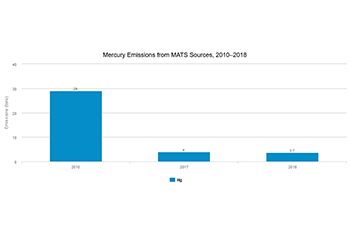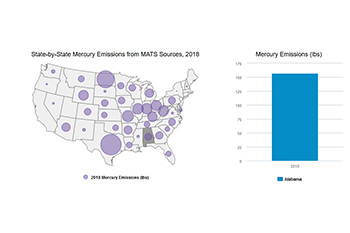Progress Report
Emission Reductions
Mercury
Source: EPA, 2019
Last updated: 12/2019
Related Figures


Highlights
Overall Results
- Mercury and other hazardous air pollutant (HAP) emissions have declined significantly since 2010 estimates. These emission reductions were driven by the installation of new pollution controls and enhancements of existing pollution controls that reduce multiple pollutants. Emissions have also decreased due to operational changes, such as fuel switching and increased generation at natural gas-fired units that emit very little mercury and HAP. These trends are discussed in Chapter 1.
- Other programs – such as regional and state SO₂ and NOₓ emission control programs – also contributed to the mercury and other HAP emission reductions achieved by covered sources in 2018.
Mercury and Hazardous Air Pollutant Emission Trends
Compared to 20101, units covered under MATS in 2018 emitted 25 fewer tons of mercury (87% reduction).
- Emissions from 2010 are estimated as described in Memorandum: Emissions Overview: Hazardous Air Pollutants in Support of the Final Mercury and Air Toxics Standard. EPA-454/R-11-014. November 2011; Docket ID No. EPA-HQ-OAR-2009-0234-19914.
Background Information
Hazardous air pollutants (HAPs) emitted by power plants include mercury, acid gases (e.g., HCl, HF), non-mercury metallic toxics (e.g., arsenic, nickel, and chromium) and organic HAPs (e.g., formaldehyde, dioxin/furan). Exposure to these pollutants at certain concentrations and durations can increase chances of cancer and immune system damage, along with neurological, reproductive, developmental, respiratory, and other health problems.
In 2011, EPA issued MATS, establishing national emission standards for mercury and other hazardous air pollutants for new and existing coal- and oil-fired power plants. The standards were finalized under section 112 of the Clean Air Act. The MATS emission standards were established using data from a 2010 information collection request (ICR) that was sent to selected coal- and oil- fired EGUs.